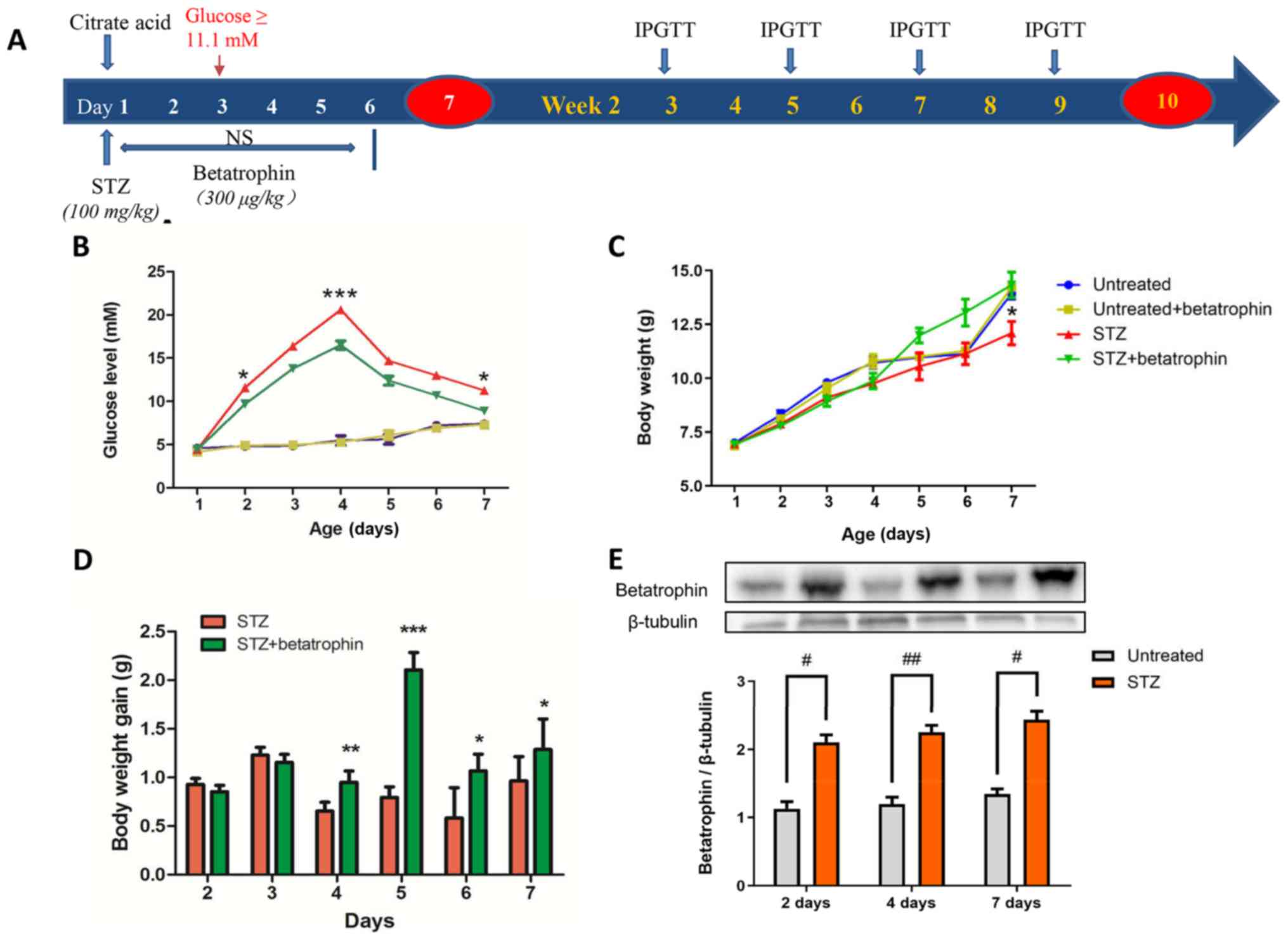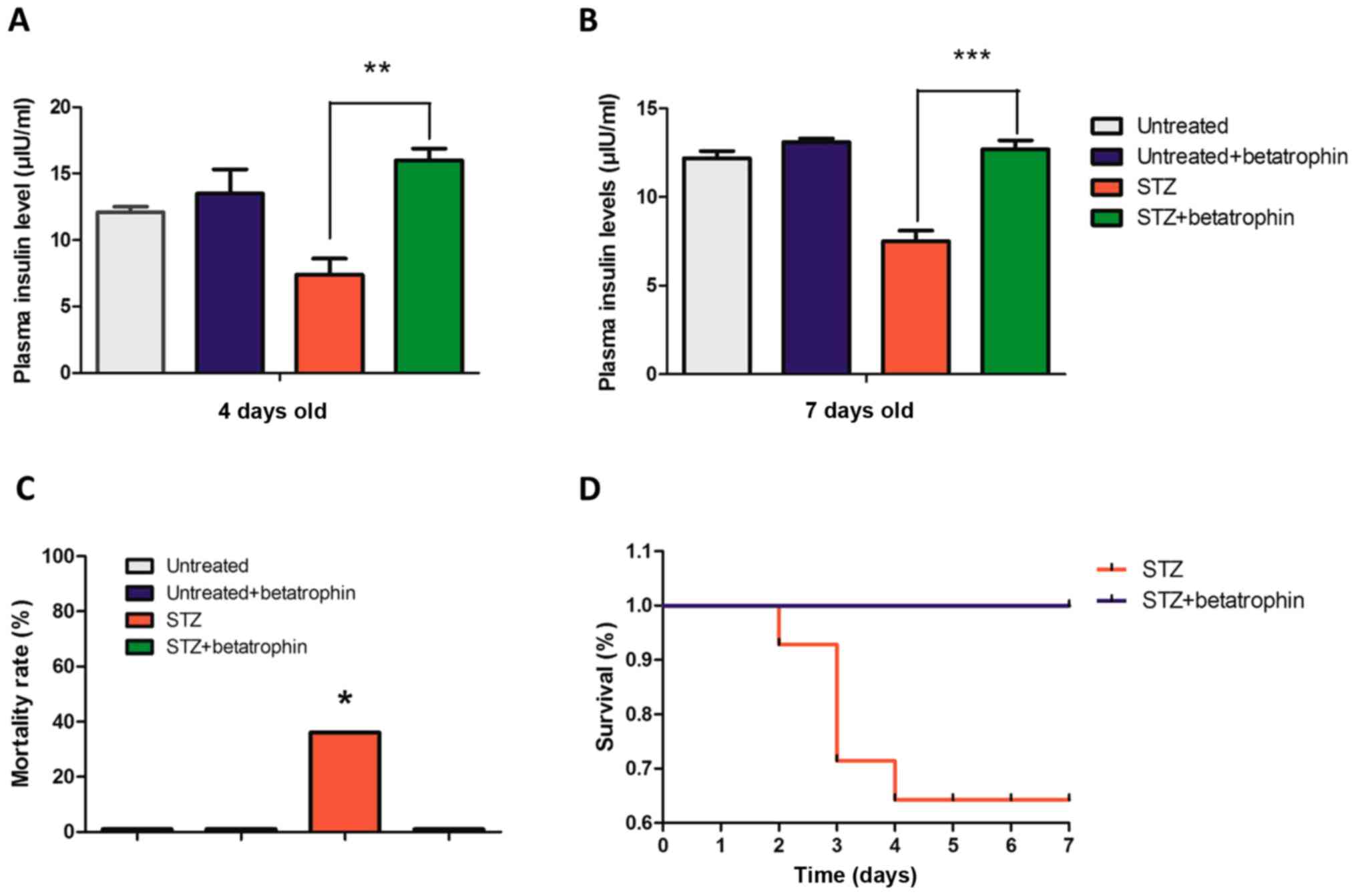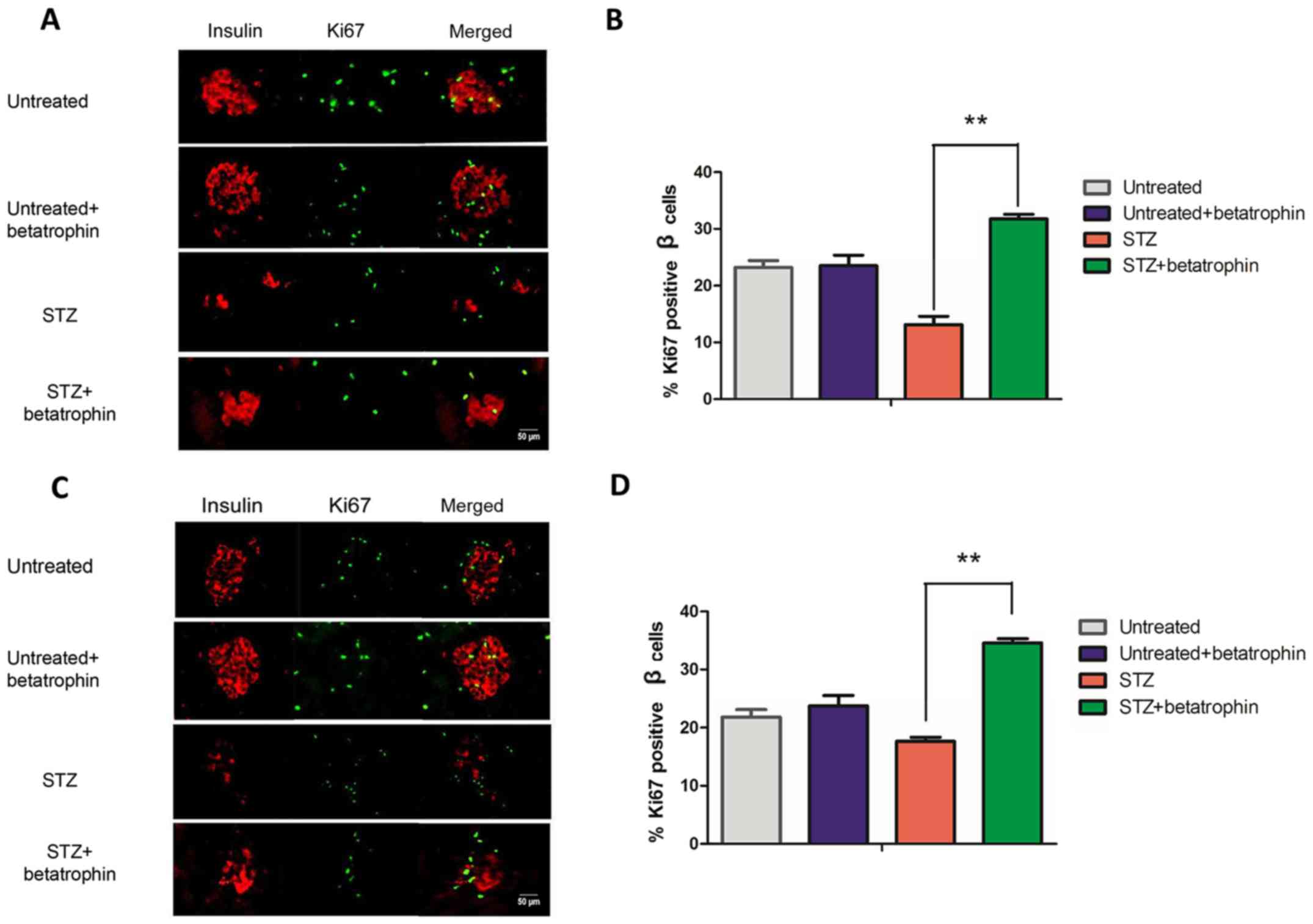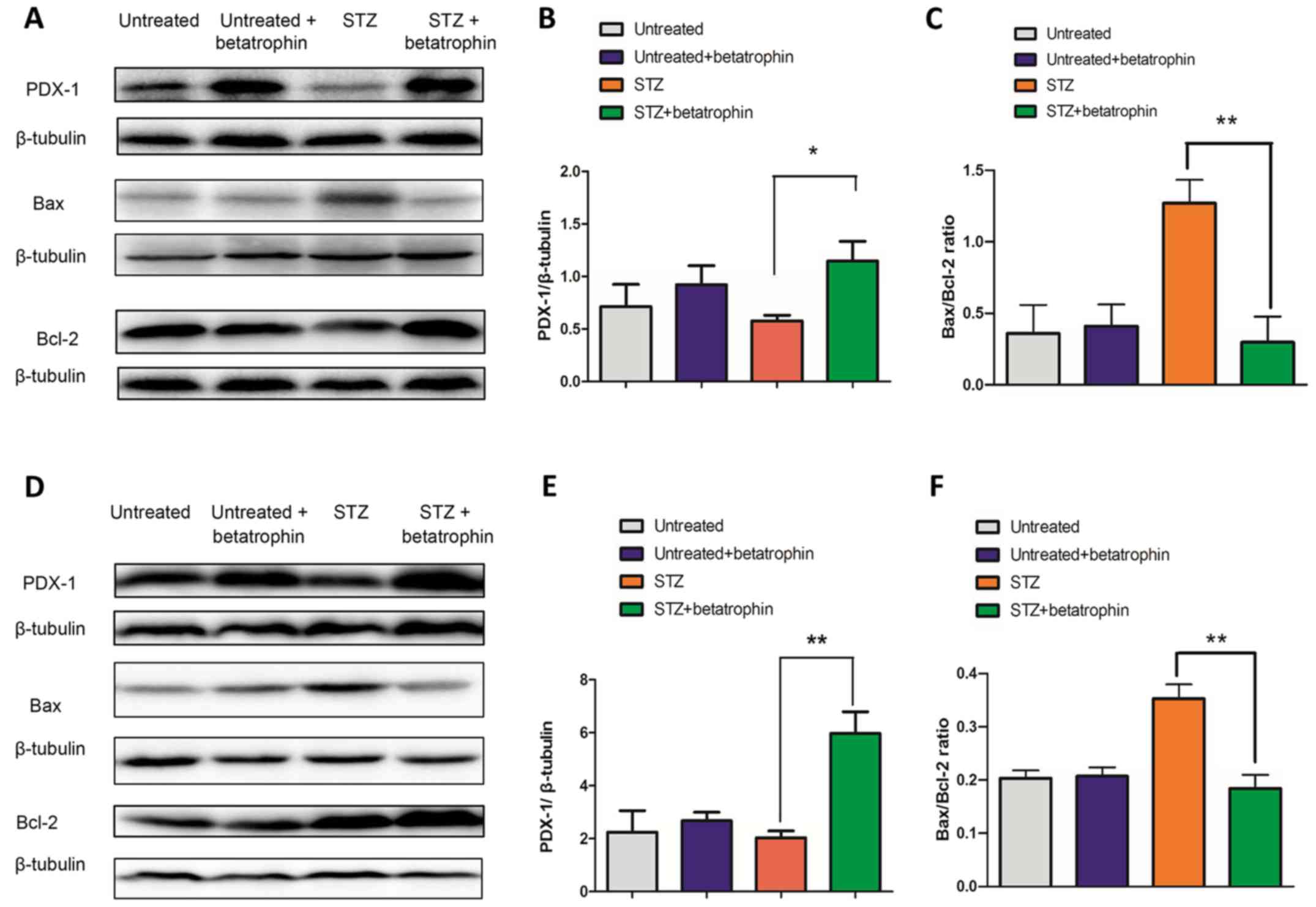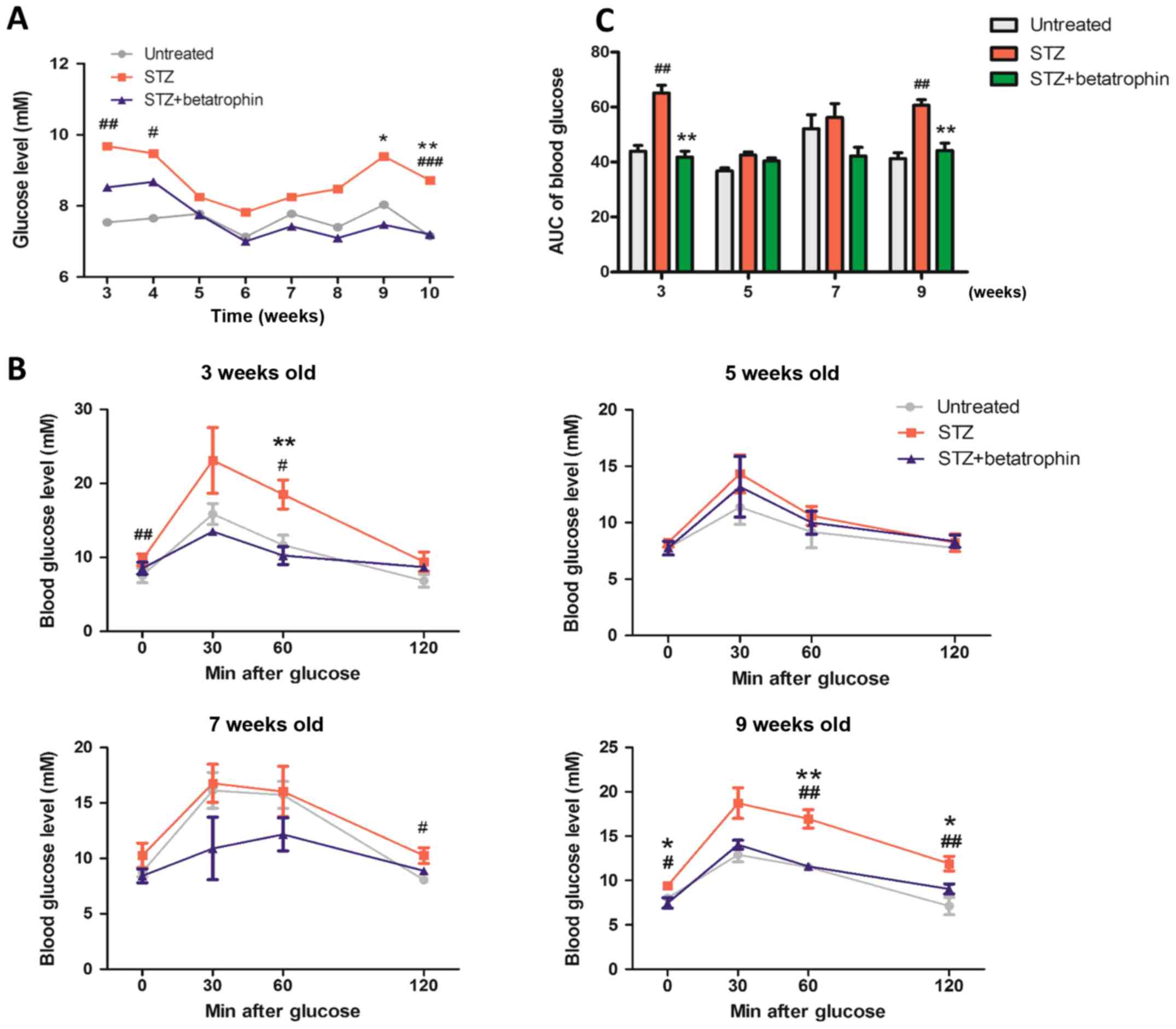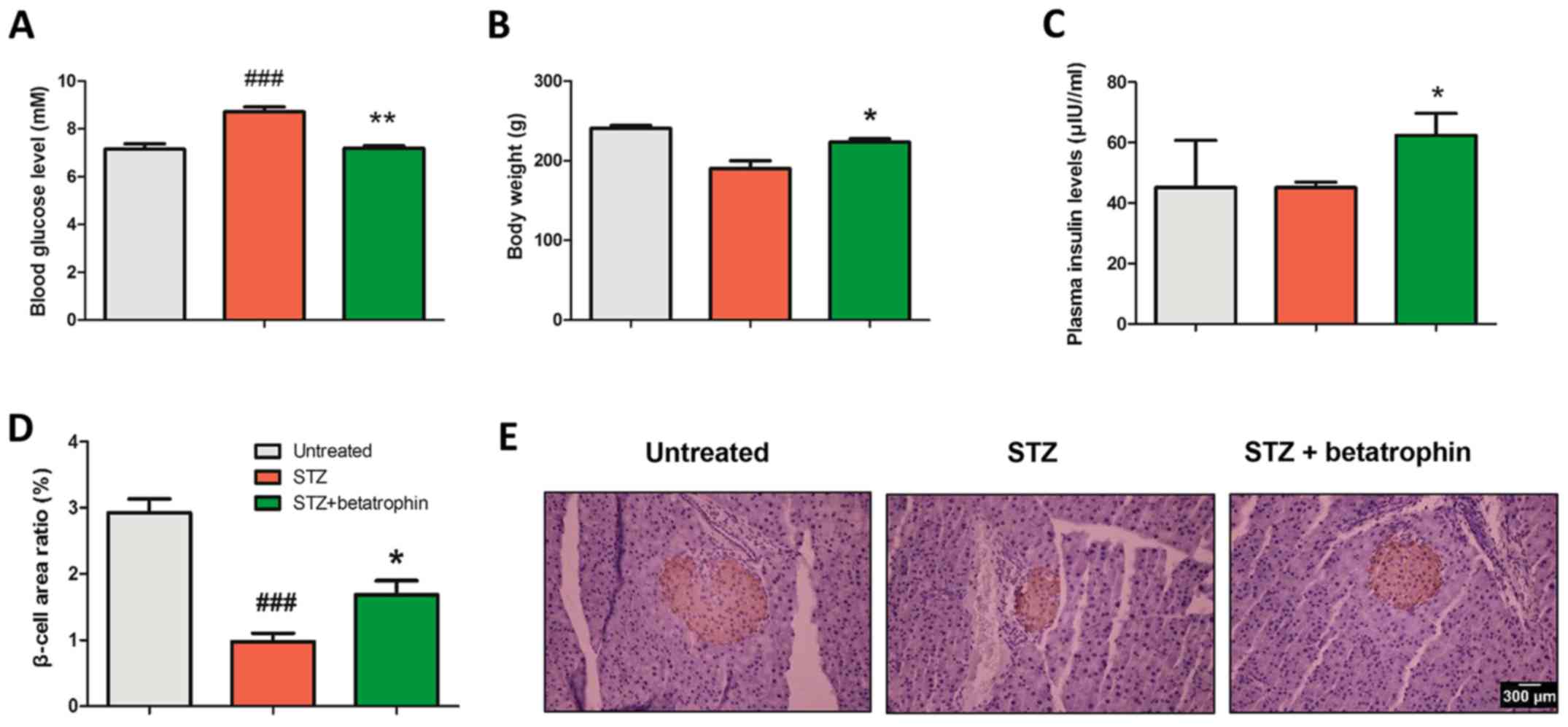Recombinant betatrophin (Angptl‑8/lipasin) ameliorates streptozotocin‑induced hyperglycemia and β‑cell destruction in neonatal rats
- Authors:
- Published online on: October 1, 2019 https://doi.org/10.3892/mmr.2019.10719
- Pages: 4523-4532
-
Copyright: © Zhang et al. This is an open access article distributed under the terms of Creative Commons Attribution License.
Abstract
Introduction
Diabetes mellitus (DM) is a complex metabolic disease, characterized by high blood glucose levels and dysfunctional lipid metabolism. DM is further classified as type 1 (TIDM) and type 2 (T2DM), caused by absolute and relative insulin insufficiency, respectively. In T1DM, inadequate mass of functional pancreatic β cells causes insulin deficiency (1). A variety of traditional treatments for diabetes, including insulin therapy, have limited ability to simulate insulin secretion and are frequently associated with severe hypoglycemic episodes (2,3). To overcome the limitations of traditional treatment, researchers have focused on replenishing the loss of insulin-producing cells and expansion of existing pancreatic β cells through regeneration (2).
The streptozotocin (STZ)-treated neonatal model is useful for investigating β-cell regeneration (4). It provides a better understanding of DM pathophysiology by exhibiting hyperglycemia, altered glucose tolerance, and reduced insulin secretion after neonatal injection of STZ (5,6).
Betatrophin, also known as lipasin (7), angiopoietin-like 8 (ANGPTL8) (8), refeeding induced in fat and liver (RIFL) (9), or hepatocellular carcinoma-associated gene TD26, is a protein in the ANGPTL family. Originally derived from liver and adipose tissues, it regulates triglyceride (TG) clearance by inhibiting lipoprotein lipase (LPL) in plasma (10).
Betatrophin is known to induce β-cell proliferation and to improve glucose tolerance in insulin resistance states (11). Jiao et al (12) found that elevated hepatic betatrophin expression increased the proliferation of β cells transplanted from mice. However, this finding is contentious. Cox et al reported that β-cell replication was not obviously altered after ANGPTL8 overexpression in B6.129 mice (13). Since the initial discovery relied on cDNA overexpression rather than direct treatment using the recombinant protein, we tested its direct effect on diabetes and β cells using a neonatal diabetes model.
Furthermore, numerous clinical studies have demonstrated that betatrophin levels are significantly increased in individuals with obesity, who are pregnant (14), with T1DM (15), with newly identified type 2 diabetes mellitus (nT2DM), T2DM, and diabetic retinopathy (16,17). These facts suggest that betatrophin may be involved in compensatory mechanisms of enhanced insulin levels. In the present study, we investigated the short- and long-term effects of betatrophin in a neonatal STZ-induced diabetes mellitus model and the underlying mechanisms.
Materials and methods
Reagents
Recombinant human betatrophin was purchased from Creative Biomart (Shirley, NY, USA), and STZ was purchased from Wako Pure Chemicals (Sigma-Aldrich; Merck KGaA).
Animals (rat model of diabetes)
Wistar rats (275.4±10.1 g per rat, n=5) at 16–18 days of pregnancy, were obtained from Qingdao Institute for Food and Drug Control. They were kept in specific pathogen-free conditions in filtered cages and were fed standard chow diets and water in a 12-h light/dark cycle and housed in standard housing conditions (22–24°C and 55±20% humidity). Each litter of pups was randomly divided into four groups (STZ group n=13, STZ+betatrophin group n=11, Untreated group n=13, Untreated+betatrophin group n=18). For neonates within 10 h of birth, rats were injected intraperitoneally (i.p.) with a single dose of STZ (100 mg/kg, freshly dissolved in 0.1 M citrate buffer, pH 4.5), or citrate buffer alone. Male animals were used for further study only if their random glucose levels were higher than 11.1 mM on day 3 measured using a glucometer (B. Braun, Meilsungen, Germany). Betatrophin (300 mg/kg, freshly dissolved in normal saline) or normal saline alone was administered to the animals by i.p. injection for 6 days (days 1–6). In the long term study, STZ and STZ+betatrophin groups were injected with a single dose of STZ (100 mg/kg) within 10 h of birth. Betatrophin (300 mg/kg) was administered to the STZ+betatrophin group by i.p. injection for 6 days (day 1–6). At least five rats in each group were maintained until the 10th week. The design of the study is presented in Fig. 1A.
Animals were sacrificed on days 2, 4, and 7 after birth by decapitation. Adult rats were sacrificed at 70 days after birth by bleeding following anesthesia with an i.p. injection of sodium pentobarbital (50 mg/kg). Blood samples were immediately collected and centrifuged at 20,000 × g for 2 min at 4°C and then stored at −20°C until assayed. The animal experimental protocol was approved by the Ethics Committee of the Medical Department of Qingdao University (Qingdao, China). All experiments were conducted in accordance with the National Institutes of Health Guide for the Care and Use of Laboratory Animals.
Measurement of body weight, blood glucose and plasma insulin levels
Blood glucose levels were measured with a glucometer from the foot pad. Body weights were measured with an electric balance (PL1501-S; Mettler Toledo, China) each day of the study. Plasma insulin levels of the 4- and 7-day-old pups were measured using an enzyme-linked immunosorbent assay kit (EIaab Science Co., Wuhan, China), following the manufacturer's protocol.
Glucose tolerance test (IPGTT)
Rats were fasted for 12 h prior to the intraperitoneal glucose tolerance test (IPGTT). Glucose levels were measured from the tail vein at 0, 30, 60 and 120 min, after an i.p. injection of glucose (2 g/kg), using a One Touch Basic glucose meter.
Western blot analysis
In the pancreas and liver tissues of 2-, 4- and 7-day-old neonates, western blot analysis of insulin promoter factor, duodenal homeobox gene-1 (PDX-1) and anti-apoptosis factor B-cell lymphoma-2 (Bcl-2) was carried out as previously described (18). Primary antibodies included rabbit anti-PDX-1 diluted at 1:4,000 (#2437, Cell Signaling Technology), rabbit anti-Bcl-2 diluted at 1:4,000 (AB1722, Millipore), rabbit anti-betatrophin diluted at 1:4,000 (ab180915, Abcam), rabbit anti-Bax diluted at 1:1,000 (#2772T, Cell Signaling Technology) and rabbit anti-β-tubulin diluted at 1:2,000 (#2128, Cell Signaling Technology). The intensity of bands was analyzed using Quantity One Software (Bio-Rad). Peroxidase-conjugated secondary antibody was diluted at 1:8,000 (ZB2301, ZSGB-BIO, Beijing, China). The protein concentration was measured using Quantity One Software (Bio-Rad).
Immunohistochemistry of the pancreas
The pancreas of each pup was rapidly harvested, weighed and fixed in 4% paraformaldehyde for 24 h. Immunohistochemistry and immunofluorescence staining analysis was performed as described previously (19). The tissues were subsequently dehydrated in graded concentrations of ethanol, cleared in xylene, embedded in paraffin and sectioned into 5-µm tissue sections. Adjacent sections at a fixed interval throughout the block were immunostained for insulin using a technique adapted from the peroxidase indirect labeling method. The sections were incubated overnight with primary antibodies against insulin (ZSGB-BIO) after 1 h blocking with 1% bovine serum albumin. They were then incubated with biotinylated secondary antibody (PV6000; ZSGB-BIO) for 3 h. Insulin positive staining was visualized with hematoxylin and eosin and mounted in 3,3′diaminobenzidine (DAB). Histological images were captured using high-power light microscopy (DP72; Olympus, Tokyo, Japan). Ten non-consecutive sections of different series per block were immunostained for insulin; at least six random islets (magnification, ×400) from each section were counted for insulin-positive areas. The β-cell area ratio was quantified as the area of insulin-positive cells divided by the total tissue area using Image J software (National Institutes of Health, Bethesda, MD, USA).
Immunofluorescence staining
The paraffin-embedded sections were deparaffinized and rehydrated using xylene, ethanol and PBS. Antigen retrieval was performed using 10 mM citrate buffer (pH 6.0) in a microwave oven for two treatments of 10 min each. Sections were blocked in 10% normal donkey serum, 1.0% bovine serum albumin (BSA) for 2 h to prevent nonspecific binding. Incubation with the primary antibody mix was performed at 4°C overnight in a wet chamber followed by incubation with the mixture of fluorophore-conjugated secondary antibody for 2 h in a wet chamber protected from light. The primary antibodies used were anti-insulin (dilution 1:1,000, E11D7; Merck Millipore) and anti-Ki67 (dilution 1:1,000, #2382594; Merck Millipore). Corresponding secondary antibodies were Rhodamine-conjugated Affinipure goat anti-mouse, and Fluorescein-conjugated Affinipure goat anti-rabbit made by ZSGB-BIO. Slides were mounted with coverslips with a drop of 50% glycerol. Fluorescence images were captured with a laser confocal microscope (FV500; Olympus). Ten non-consecutive sections of different series per block were immunostained for insulin; at least five random islets from each section were measured to determine the proportion of insulin/Ki67 co-localized cells of the total β cells which was counted using ImageJ software.
Statistical analysis
Data are expressed as mean ± SEM and analyzed using ANOVA. The LSD (least significance difference) test was used as the post-hoc test, with the Student's t-test and the Fisher's exact test, with statistical significance set at P<0.05.
Results
Betatrophin treatment decreases STZ-promoted hyperglycemia in neonatal rats
In order to establish neonatal diabetes by specifically destroying β cells, STZ at 100 mg/kg was injected into newborn pups 10 h after birth, as previously described (20). As shown in Fig. 1B, compared to the untreated pups, STZ treatment caused a steady elevation in blood glucose level from 5 to 22 mM over 4 days. Glucose levels then gradually declined from 4 to 7 days to 13 mM, suggesting a partial recovery from diabetes. The expression of endogenous betatrophin in the liver doubled from day 2 in the STZ group compared to levels in untreated pups, suggesting possible involvement of betatrophin in diabetes (Fig. 1E).
Betatrophin+STZ treatments also caused substantial increases in glucose levels, however, to a significantly lesser extent especially on days 2, 4 and 7 and only peaked at 16 mM (Fig. 1B). Body weight was significantly different between the STZ and STZ+betatrophin groups on day 7 (12.81±0.37 g, n=9 vs. 13.82±0.25 g, n=11). There was a tendency of the STZ+betatrophin rats to grow faster from the 4th to the 7th day of age (Fig. 1C). STZ treatment caused a slight delay in weight gain (Fig. 1D) and a decrease in pancreatic weight, especially on day 7, both of which were prevented by betatrophin treatment (Fig. 1 and Table I).
Betatrophin treatment reverses the depletion of plasma insulin and the mortality caused by STZ
With partial destruction of β cells, plasma insulin levels in neonatal rats were significantly lower by approximately 30% at 4 and 7 days after STZ injection, an effect that was completely reversed by the treatment of recombinant betatrophin (Fig. 2A and B). Treatment with betatrophin alone in normal neonates did not significantly affect insulin levels.
STZ injection caused very severe hyperglycemia. The affected pups became pale and inactive, and 36% of them in fact died within 2–4 days (Fig. 2C and D). This high mortality rate was once again completely prevented by co-treatment of betatrophin, supporting the notion that early administration of betatrophin protected the newborns from diabetes and mortality.
Betatrophin treatment promotes β-cell proliferation in STZ-treated rats
Betatrophin may protect neonatal pups by preventing β-cell death caused by STZ, or by promoting β-cell proliferation thereby replacing the lost cells. In order to determine whether the increase in plasma insulin level after betatrophin administration in the STZ+betatrophin rats was due to enhancement in β-cell replication, we performed immunofluorescence on pancreatic sections from 4- and 7-day-old pups. Cell proliferation was labeled using nuclear protein Ki67 and colocalized to β cells using insulin (Fig. 3) The ratios of Ki67-positive β cells were calculated from representative images, and the results illustrated using bar graphs. It was found that, in 4-day-old pups, 23% of the β cells underwent proliferation normally; STZ treatment caused a 50% reduction to 12%, while betatrophin+STZ treatment resulted in higher than normal ratios of β-cell proliferation to 32% (Fig. 3A and B, 4th vs. 3rd bar). The rate of β-cell proliferation was greater than restored, consistent with the restored insulin level. A similar result was obtained at 7 days, while a 20% decrease in β-cell proliferation by STZ treatment was more than fully compensated to 35% of the normal ratio (Fig. 3C and D, 4th vs. 3rd bar).
Betatrophin treatment increases PDX-1 and reduces the Bax/Bcl-2 ratio in STZ-treated neonatal pancreas
To identify the mechanism governing the restoration of β-cell proliferation and insulin production, we examined possible changes in expression of PDX-1, a key transcriptional factor involved in pancreatic development and β-cell function, as well as that of pro-apoptosis protein Bax and anti-apoptotic protein Bcl-2. Western blot analysis and densitometry showed that PDX-1 levels were only slightly decreased by STZ treatment at either 4 or 7 days (Fig. 4A, B, D and E, 3rd vs. 1st bars); betatrophin+STZ treatments significantly increased PDX-1 levels to 1.3 and 3-fold above STZ-treated levels, respectively (4th vs. 3rd bars). Betatrophin treatment itself had no effect on normal PDX-1 expression in young rats (2nd vs. 1st bars).
At 4 and 7 days, betatrophin treatment significantly reduced Bax protein expression, while increased Bcl-2 protein level in the STZ-treated rats (Fig. 4A and D). Thus, betatrophin caused inhibitory effect on the ratio of Bax/Bcl-2 (P<0.05, Fig. 4C and F, 4th vs. 3rd bars). No difference in the Bax/Bcl-2 ratio was observed between the untreated and untreated+betatrophin group (P>0.05, Fig. 4C and 4F, 1st vs. 2nd bars). The changes in PDX-1 and Bcl-2 levels indicate potential stimulation by the treatment of betatrophin and potential involvement in restoring β-cell mass, function and/or rescuing from diabetes.
Long-term effects on blood glucose, insulin levels, glucose tolerance and β-cell mass after neonatal treatments of STZ and betatrophin
To study the recovery from acute STZ and betatrophin treatments in the newborn period and in addition to studying the possible long-term influence of betatrophin administration, we followed a group of pups until they reached adulthood at 10 weeks. Fig. 5A illustrates the changes in overnight fasting blood glucose levels. There was hyperglycemia at 3, 4, 9 and 10 weeks with transient normalization to close-to-normal over 5–8 weeks. Betatrophin-treated mice displayed largely normalized glycemia from STZ, close to that of the untreated rats.
Intraperitoneal glucose tolerance was assessed at 3, 5, 7 and 9 weeks (Fig. 5B). On both occasions, STZ-treated rats exhibited glucose intolerance as opposed to untreated animals. Those treated with betatrophin exhibited completely normalized responses, indistinguishable from those of the untreated rats, but significantly lower than those of STZ alone treated rats (Fig. 5C using AUC). These results suggest that STZ treatment resulted in a long-term glucose intolerance that was corrected by treatment with betatrophin during the neonatal period. The effect was persistent.
The animals were then sacrificed at 10 weeks of age. As shown in Fig. 6A and B, STZ rats with glucose intolerance and hyperglycemia had significantly lower body weights (−15%) and elevated blood glucose levels (+15%). Early treatment with betatrophin significantly improved body weight to 95% of the normal as well as normalizing blood glucose levels. Betatrophin treatment significantly increased serum insulin levels by 15% compared to the STZ group (Fig. 6C).
Finally, we assessed the islet morphology using immunohistochemistry (Fig. 6E). On average, STZ-treated rats exhibited smaller islets that were stained using insulin antibody. Treatment of betatrophin in addition to STZ caused significant normalization (Fig. 6D). STZ rats exhibited only 1/3 of the β-cell area of the untreated rats, that was increased to 55% by treatment with betatrophin. These results suggest that neonatal STZ administration causes reduced insulin production in the pancreas and reduced hyperglycemia from newborn to 10 weeks of age. Betatrophin treatment may prevent this deterioration via maintenance of insulin-positive cells and insulin production.
Discussion
The neonatal STZ-induced diabetes mellitus model is valuable to study the regeneration of β cells. Streptozotocin (STZ) administration with 100 mg/kg body weight in newborn rats causes severe destruction in β cells, followed by spontaneous remission. Several studies have reported that this partial recovery of β cells may be modulated by exogenous factors (20,21). In the present study, we investigated whether recombinant betatrophin has a potentially protective effect on neonatal STZ-induced diabetic rats. Our results showed that administration of recombinant betatrophin during the neonatal period alleviated hyperglycemia by promoting β-cell proliferation, and exhibited anti-diabetic properties in adults in a neonatal STZ-induced diabetic rat model.
We found that endogenous betatrophin levels in the liver were higher in STZ rats than that in the untreated rats (Fig. 1E), consistent with the observation that serum betatrophin levels were increased in long-term T1DM patients (15). These observations suggest that betatrophin may participate in a compensatory mechanism. Further investigation of the effect of betatrophin in T1DM, it was found that betatrophin ameliorated hyperglycemia in neonatal STZ-induce diabetic rats (Fig. 1), in accordance with previous reports showing that betatrophin improved hyperglycemia (22,23). It was also found that STZ-induced diabetic rats gained significantly less weight in the first week than did the untreated rats (Fig. 1C), while betatrophin improved the body weight gain of diabetic rats from days 4 to 7 (Fig. 1D), suggesting an anti-diabetic effect of betatrophin in the increasing severity of the diabetic state. In Fig. 1B, the STZ treated rats exhibited insulin deficient acute diabetes mellitus 3–5 days after birth. The hyperglycemia observed in the neonates following STZ is only transient which is followed by spontaneous remission (24). Both high rates of replication and neogenesis are known to contribute to the increase in β-cell mass in the neonatal pancreas during the first week (25). Thus, a possible explanation for the decline in glucose level could be the compensatory proliferation of exciting β cells.
We measured plasma insulin levels on days 4 and 7 (Fig. 2A and B), and found an increase in insulin levels after betatrophin treatment in the diabetic rats, consistent with the observed glucose changes (Fig. 1B). We also found an interesting phenomenon to the effect that neonates became pale and inactive after STZ administration. Betatrophin improved the survival rate from 64 to 100% on day 7, suggesting that early betatrophin treatment may protect neonates from death induced by acute hyperglycemia and liver damage. Zhang et al reported that betatrophin is a stress response protein that increases expression of early response transcription factor (Egr1) (26). Other studies reported marked elevation of betatrophin levels in cord blood and placental tissues (27,28). Taken together, these data suggest that betatrophin may play a key role in growth and development during the fetal and perinatal period.
Both high rates of replication and neogenesis contribute to the increase in β-cell mass in the neonatal pancreas during the first week of life (24). Betatrophin displayed dramatic effects on proliferation and expansion of pancreatic β cells (29). In the present study, betatrophin did not trigger the proliferation of β cells in normal neonates, but increased the proliferating β-cell number. Nevertheless, this function of betatrophin on β-cell replication has been disputed in subsequent studies (13,30), that used ANGPTL8-deficient and ANGPTL8-overexpressing mice. This phenomenon can be explained as betatrophin promotes β-cell proliferation only under circumstances of β-cell deficiency. Another possible reason is that there are several interconnected compensatory mechanisms that regulate cell homeostasis in mice. We therefore hypothesized that betatrophin treatment would promote β-cell proliferation in STZ-induced diabetic neonates with insulin deficiency. In support of our hypothesis, we found increased Ki67-positive cells, representing an elevated rate of cell proliferation in response to betatrophin treatment at two different ages (Fig. 3B and D). This result agrees with previous findings showing that betatrophin promotes β-cell proliferation and expansion (12,22,23).
We found that betatrophin upregulated the expression of PDX-1 and decreased the Bax/Bcl-2 ratio in the pancreas in neonatal STZ-induced diabetic rats. PDX-1 is a necessary transcription factor for pancreatic development and β-cell differentiation. β cells with reduced PDX-1 expression have an increased rate of apoptosis (31). Bcl-2 is an important anti-apoptotic protein, and Bax is an pro-apoptotic protein (32). In the present study, the upregulated pancreatic expression of PDX-1 and the decreased Bax/Bcl-2 ratio suggest that betatrophin may expand the β-cell mass by enhancing activation of anti-apoptotic mechanisms and promoting differentiation of stem cells into β cells as well as promoting β-cell proliferation. It was reported that betatrophin regulates inflammation via the NF-κB pathway (33–35). Inflammation is one of the factors leading to apoptosis. We assessed a pro-apoptosis marker with western blot analysis. The ratio of Bax/Bcl-2 indicates that inflammation may exist in the early stage, eventually leading to β-cell apoptosis. Betatrophin may reduce inflammation and eventually improve the apoptosis rate of β cells.
This study was the first to determine that betatrophin preserves islet cell mass and prevents diabetes in adult rats in a neonatal STZ-diabetic rat model. Early administration of betatrophin showed anti-diabetic potential by reducing plasma glucose, elevating insulin levels, and improving body weight and glucose tolerance test (IPGTT) in adult rats (Fig. 5). It is likely that STZ has no long-acting effects on pancreatic islets. Therefore, at weeks 5 and 7, the result of the IPGTT was normal in the STZ group. Moreover, there was a higher demand for β-cell mass to maintain normal glucose tolerance. The regeneration and proliferation of β cells in the STZ group might account for the recovery of impaired glucose tolerance. Although plasma insulin levels in the STZ group were equal to that of the untreated group, blood glucose levels of the STZ rats was higher than those of untreated rats (Fig. 6A and C). It is possible that newly regenerated islets in the STZ group are able to release similar amounts of insulin. However, the insulin responsiveness may have been impaired due to earlier diabetic damage. There may be other unaccounted compensatory changes behind this discovery. Immunohistochemistry revealed that betatrophin increased pancreatic islet area (Fig. 6D). There were few large islets in the STZ-treated rats (Fig. 6E). These results strongly favor the conclusion that betatrophin prevents development of diabetes in adult rats by stimulating β-cell proliferation in the neonatal STZ-induced diabetes model. Betatrophin as an adipokine, played a beneficial role in β-cell proliferation and function. We previously reported that betatrophin (ANGPTL8) is closely linked to T2DM and insulin resistance (17). In the present study, we confirmed that betatrophin improved glucose tolerance and promoted β-cell proliferation. Moreover, our group also found that betatrophin decreased the FFA level (36). Thus, betatrophin may be a promising and attractive target for the treatment of obesity and T2DM.
In summary, this study firstly illuminated that administration of recombinant betatrophin during the neonatal period promoted β-cell proliferation, and exhibited anti-diabetic properties in the adult rat in a neonatal STZ-induced diabetic rat model.
Acknowledgements
Not applicable.
Funding
This study was supported by the National Natural Science Foundation of China (no. 31872791 to JD), Natural Science Foundation of Shandong Province of China (no. ZR2019MC046 to JD), and Natural Science and Engineering Research Council of Canada (NSERC) to JLL (RGPIN-2017-05246).
Availability of data and materials
The datasets used and/or analyzed during the current study are available from the corresponding author on reasonable request.
Authors' contributions
DZ and YJY designed and performed the experiments, and researched the data. DZ wrote the manuscript. JHY, RW, CSZ, LXW, YL and LMS contributed to discussion of the experiments and analysis of the data and results. JD and JLL directed the project, contributed to the discussion and analysis of the results, and reviewed and edited the manuscript. JD as the corresponding author had full access to all the data in the study and had final responsibility for the decision to submit for publication. FSX interpreted the results and revised the manuscript. All authors read and approved the final manuscript.
Ethics approval and consent to participate
The protocol was approved by the Ethics Committee of the Medical Department of Qingdao University (Qingdao, China). All experiments were conducted in accordance with the National Institutes of Health Guide for the Care and Use of Laboratory Animals.
Patient consent for publication
Not applicable.
Competing interests
The authors declare that they have no competing interests.
References
|
Shan R, Sarkar S and Martin SS: Digital health technology and mobile devices for the management of diabetes mellitus: State of the art. Diabetologia. 62:877–887. 2019. View Article : Google Scholar : PubMed/NCBI | |
|
Wang H, Bender A, Wang P, Karakose E, Inabnet WB, Libutti SK, Arnold A, Lambertini L, Stang M, Chen H, et al: Insights into beta cell regeneration for diabetes via integration of molecular landscapes in human insulinomas. Nat Commun. 8:7672017. View Article : Google Scholar : PubMed/NCBI | |
|
Yu LT, Yang MQ, Liu JL, Alfred MO, Li X, Zhang XQ, Zhang J, Wu MY, Wang M and Luo C: Recombinant Reg3α protein protects against experimental acute pancreatitis in mice. Mol Cell Endocrinol. 422:150–159. 2016. View Article : Google Scholar : PubMed/NCBI | |
|
Kataoka M, Kawamuro Y, Shiraki N, Miki R, Sakano D, Yoshida T, Yasukawa T, Kume K and Kume S: Recovery from diabetes in neonatal mice after a low-dose streptozotocin treatment. Biochem Biophys Res Commun. 430:1103–1108. 2013. View Article : Google Scholar : PubMed/NCBI | |
|
Howarth FC and Qureshi MA: Characterisation of ventricular myocyte shortening after administration of streptozotocin (STZ) to neonatal rats. Arch Physiol Biochem. 109:200–205. 2001. View Article : Google Scholar : PubMed/NCBI | |
|
Takada J, Machado MA, Peres SB, Brito LC, Borges-Silva CN, Costa CE, Fonseca-Alaniz MH, Andreotti S and Lima FB: Neonatal streptozotocin-induced diabetes mellitus: A model of insulin resistance associated with loss of adipose mass. Metabolism. 56:977–984. 2007. View Article : Google Scholar : PubMed/NCBI | |
|
Zhang R: Lipasin, a novel nutritionally-regulated liver-enriched factor that regulates serum triglyceride levels. Biochem Biophys Res Commun. 424:786–792. 2012. View Article : Google Scholar : PubMed/NCBI | |
|
Abu-Farha M, Abubaker J and Tuomilehto J: ANGPTL8 (betatrophin) role in diabetes and metabolic diseases. Diabetes Metab Res Rev. 332017.doi: 10.1002/dmrr.2919. | |
|
Ren G, Kim JY and Smas CM: Identification of RIFL, a novel adipocyte-enriched insulin target gene with a role in lipid metabolism. Am J Physiol Endocrinol Metab. 303:E334–E351. 2012. View Article : Google Scholar : PubMed/NCBI | |
|
Zhang R and Abou-Samra AB: Emerging roles of Lipasin as a critical lipid regulator. Biochem Biophys Res Commun. 432:401–405. 2013. View Article : Google Scholar : PubMed/NCBI | |
|
Raghow R: Betatrophin: A liver-derived hormone for the pancreatic β-cell proliferation. World J Diabetes. 4:234–237. 2013. View Article : Google Scholar : PubMed/NCBI | |
|
Jiao Y, Le Lay J, Yu M, Naji A and Kaestner KH: Elevated mouse hepatic betatrophin expression does not increase human β-cell replication in the transplant setting. Diabetes. 63:1283–1288. 2014. View Article : Google Scholar : PubMed/NCBI | |
|
Cox AR, Lam CJ, Bonnyman CW, Chavez J, Rios JS and Kushner JA: Angiopoietin-like protein 8 (ANGPTL8)/betatrophin overexpression does not increase beta cell proliferation in mice. Diabetologia. 58:1523–1531. 2015. View Article : Google Scholar : PubMed/NCBI | |
|
Trebotic LK, Klimek P, Thomas A, Fenzl A, Leitner K, Springer S, Kiefer FW and Kautzky-Willer A: Circulating betatrophin is strongly increased in pregnancy and gestational diabetes mellitus. PLoS One. 10:e01367012015. View Article : Google Scholar : PubMed/NCBI | |
|
Espes D, Lau J and Carlsson PO: Increased circulating levels of betatrophin in individuals with long-standing type 1 diabetes. Diabetologia. 57:50–53. 2014. View Article : Google Scholar : PubMed/NCBI | |
|
Fu Z, Berhane F, Fite A, Seyoum B, Abou-Samra AB and Zhang R: Elevated circulating lipasin/betatrophin in human type 2 diabetes and obesity. Sci Rep. 4:50132014. View Article : Google Scholar : PubMed/NCBI | |
|
Wang YY, Zhang D, Jiang ZY, Lu XQ, Zheng X, Yu YJ, Wang YG and Dong J: Positive association between betatrophin and diabetic retinopathy risk in Type 2 diabetes patients. Horm Metab Res. 48:169–173. 2016. View Article : Google Scholar : PubMed/NCBI | |
|
Yuan JH, Chen X, Dong J, Zhang D, Song K, Zhang Y, Wu GB, Hu XH, Jiang ZY and Chen P: Nesfatin-1 in the lateral parabrachial nucleus inhibits food intake, modulates excitability of glucosensing neurons, and enhances UCP1 expression in brown adipose tissue. Front Physiol. 8:2352017. View Article : Google Scholar : PubMed/NCBI | |
|
Li Q, Li B, Miao X, Ramgattie C, Gao ZH and Liu JL: Reg2 Expression is required for pancreatic islet compensation in response to aging and high-fat diet-induced obesity. Endocrinology. 158:1634–1644. 2017. View Article : Google Scholar : PubMed/NCBI | |
|
Irako T, Akamizu T, Hosoda H, Iwakura H, Ariyasu H, Tojo K, Tajima N and Kangawa K: Ghrelin prevents development of diabetes at adult age in streptozotocin-treated newborn rats. Diabetologia. 49:1264–1273. 2006. View Article : Google Scholar : PubMed/NCBI | |
|
Tourrel C, Bailbé D, Meile MJ, Kergoat M and Portha B: Glucagon-like peptide-1 and exendin-4 stimulate beta-cell neogenesis in streptozotocin-treated newborn rats resulting in persistently improved glucose homeostasis at adult age. Diabetes. 50:1562–1570. 2001. View Article : Google Scholar : PubMed/NCBI | |
|
Chen J, Chen S, Huang P, Meng XL, Clayton S, Shen JS and Grayburn PA: In vivo targeted delivery of ANGPTL8 gene for beta cell regeneration in rats. Diabetologia. 58:1036–1044. 2015. View Article : Google Scholar : PubMed/NCBI | |
|
Sun LL, Liu TJ, Li L, Tang W, Zou JJ, Chen XF, Zheng JY, Jiang BG and Shi YQ: Transplantation of betatrophin-expressing adipose-derived mesenchymal stem cells induces β-cell proliferation in diabetic mice. Int J Mol Med. 39:936–948. 2017. View Article : Google Scholar : PubMed/NCBI | |
|
Wang RN, Bouwens L and Klöppel G: Beta-cell proliferation in normal and streptozotocin-treated newborn rats: Site, dynamics and capacity. Diabetologia. 37:1088–1096. 1994. View Article : Google Scholar : PubMed/NCBI | |
|
Kassem SA, Ariel I, Thornton PS, Scheimberg I and Glaser B: Beta-cell proliferation and apoptosis in the developing normal human pancreas and in hyperinsulinism of infancy. Diabetes. 49:1325–1333. 2000. View Article : Google Scholar : PubMed/NCBI | |
|
Zhang Y, Li S, Donelan W, Xie C, Wang H, Wu Q, Purich DL, Reeves WH, Tang D and Yang LJ: Angiopoietin-like protein 8 (betatrophin) is a stress-response protein that down-regulates expression of adipocyte triglyceride lipase. Biochim Biophys Acta. 1861:130–137. 2016. View Article : Google Scholar : PubMed/NCBI | |
|
Martinez-Perez B, Ejarque M, Gutierrez C, Nuñez-Roa C, Roche K, Vila-Bedmar R, Ballesteros M, Redondo-Angulo I, Planavila A, Villarroya F, et al: Angiopoietin-like protein 8 (ANGPTL8) in pregnancy: A brown adipose tissue-derived endocrine factor with a potential role in fetal growth. Transl Res. 178:1–12. 2016. View Article : Google Scholar : PubMed/NCBI | |
|
Wawrusiewicz-Kurylonek N, Telejko B, Kuzmicki M, Sobota A, Lipinska D, Pliszka J, Raczkowska B, Kuc P, Urban R, Szamatowicz J, et al: Increased maternal and cord blood betatrophin in gestational diabetes. PLoS One. 10:e01311712015. View Article : Google Scholar : PubMed/NCBI | |
|
Stewart AF: Betatrophin versus bitter-trophin and the elephant in the room: Time for a new normal in β-cell regeneration research. Diabetes. 63:1198–1199. 2014. View Article : Google Scholar : PubMed/NCBI | |
|
Gusarova V, Alexa CA, Na E, Stevis PE, Xin Y, Bonner-Weir S, Cohen JC, Hobbs HH, Murphy AJ, Yancopoulos GD and Gromada J: ANGPTL8/betatrophin does not control pancreatic beta cell expansion. Cell. 159:691–696. 2014. View Article : Google Scholar : PubMed/NCBI | |
|
Spaeth JM, Gupte M, Perelis M, Yang YP, Cyphert H, Guo S, Liu JH, Guo M, Bass J, Magnuson MA, et al: Defining a novel role for the Pdx1 transcription factor in islet β-cell maturation and proliferation during weaning. Diabetes. 66:2830–2839. 2017. View Article : Google Scholar : PubMed/NCBI | |
|
Singh R, Letai A and Sarosiek K: Regulation of apoptosis in health and disease: The balancing act of BCL-2 family proteins. Nat Rev Mol Cell Biol. 20:175–193. 2019. View Article : Google Scholar : PubMed/NCBI | |
|
Zhang Y, Zheng L and Huang K: A new way to regulate inflammation: Selective autophagic degradation of IKKY mediated by ANGPTL8. Cell Stress. 2:66–68. 2018. View Article : Google Scholar : PubMed/NCBI | |
|
Luo D, Chen X, Yang W, Ran W and Wen Z: Angiopoietin-like 8 improves insulin resistance and attenuates adipose tissue inflammation in diet-induced obese mice. Exp Clin Endocrinol Diabetes. Sep 26–2018.doi: 10.1055/a-0725-7897 (Epub ahead of print). | |
|
Zhang Y, Guo X, Yan W, Chen Y, Ke M, Cheng C, Zhu X, Xue W, Zhou Q, Zheng L, et al: ANGPTL8 negatively regulates NF-κB activation by facilitating selective autophagic degradation of IKKY. Nat Commun. 8:21642017. View Article : Google Scholar : PubMed/NCBI | |
|
Wang R, Yuan J, Zhang C, Wang L, Liu Y, Song L, Zhong W, Chen X and Dong J: Neuropeptide Y-positive neurons in the dorsomedial hypothalamus are involved in the anorexic effect of Angptl8. Front Mol Neurosci. 11:4512018. View Article : Google Scholar : PubMed/NCBI |



